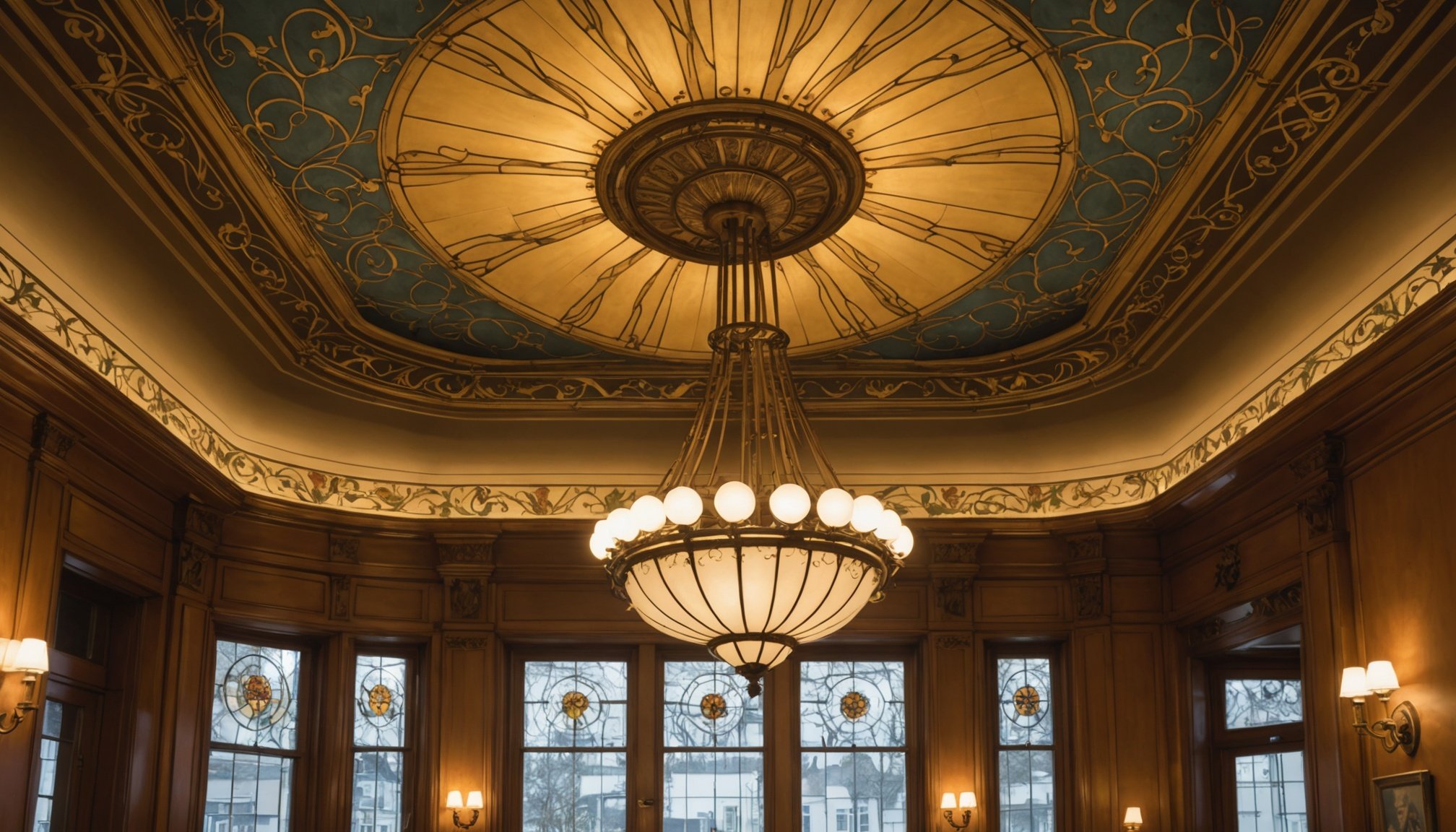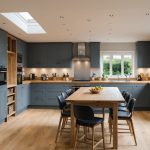Understanding Art Nouveau Design Principles
Art Nouveau design emerged at the turn of the 20th century, characterised by its decorative flair and organic forms. This design movement seamlessly integrates architecture, interior design, and visual arts, resulting in a harmonious and dynamic aesthetic. At the core of Art Nouveau design is the fusion of natural and geometric patterns, which conveys both elegance and vitality.
Historical Context and Evolution
Rooted in the late 19th century, Art Nouveau was a response to the Industrial Revolution’s mass-production. Artists and architects sought unique, handcrafted creations, emphasising functionality alongside beauty. The movement influenced diverse creative fields, from architecture to textiles, cultivating a distinctive style that prioritised individual expression.
Also to discover : Top Soundproofing Tips for Peaceful Living in UK Cities: Your Guide to Urban Serenity
Lighting Principles and Impact
A notable feature of Art Nouveau design is its treatment of light. Intricate lighting principles play a pivotal role in highlighting architectural features. Lamps and fixtures often incorporate floral and flowing forms, casting soft, ambient light to enhance spaces’ natural beauty. Such designs not only serve functional purposes but also contribute to the overall visual impact, creating an inviting and sophisticated atmosphere.
Art Nouveau remains a significant influence in the modern world, championing the timeless blend of art and utility. Its emphasis on craftsmanship and attention to detail continues to inspire designers globally.
In the same genre : Brightening Up: Innovative Strategies to Maximize Natural Light in Your UK Basement Conversion
Techniques for Illuminating Architectural Features
Architectural features are the soul of a building, with lighting techniques acting as the brushstrokes that bring them to life. Effective feature lighting involves a blend of methods to accentuate design elements while creating the desired atmosphere.
Various methods are employed to highlight architectural details. Uplighting, for example, directs light upwards to add drama by casting shadows, whereas silhouetting places light behind a feature, highlighting its outline. Grazing light emphasizes texture by placing light sources close to surfaces.
Both natural and artificial lighting play pivotal roles in design. Natural light changes throughout the day, offering dynamic illumination that can enhance a space’s mood. On the other hand, artificial light provides consistency, allowing for control over intensity and direction. Combining these sources allows architects to craft luminous environments tailored to specific purposes and aesthetics.
Comparatively, uplighting creates dramatic enhancements, suitable for gardens or facades, while silhouetting works best when contrasting with structures, like statues. Grazing is ideal for highlighting texture in materials like brick or stone, sharing the tactile beauty of the surface.
Understanding the nuances involved in these lighting techniques aids in achieving a balanced design that pays homage to both function and aesthetic appeal. The right combination of light and shadow can transform mundane architectural features into focal points that captivate and inspire.
Practical Tips for Home Illumination
Understanding the dynamics of home lighting can elevate both the aesthetics and functionality of your space. Selecting the right fixtures and lamps is crucial. Begin by identifying the purpose of each room. For instance, kitchens may benefit from bright task lighting, while living rooms might require ambient lighting for relaxation. Art Nouveau lighting can add a touch of elegance; look out for fixtures with organic designs and intricate details which complement this style.
Creating Ambient, Task, and Accent Lighting
To illuminate your home effectively, design a layered lighting scheme. Ambient lighting sets the overall mood. Implement soft light from ceiling fixtures or large lamps. Task lighting, essential for activities like reading, can be achieved with desk or pendant lamps focused on specific areas. Accent lighting highlights artwork or architectural features, making use of spotlights or track lights.
Cost-Effective Art Nouveau Integration
Incorporating Art Nouveau lighting doesn’t have to break the bank. Look for replicas or vintage pieces in thrift shops. Alternatively, Art Nouveau-inspired decal decorations can mimic the intricate patterns characteristic of this style. This offers a budget-friendly way to enjoy the elegance of Art Nouveau without significant expenditure.
Carefully considering these elements ensures a balanced and stylishly lit home.
Case Studies of Art Nouveau Lighting in UK Homes
Navigating the allure of Art Nouveau lighting within UK homes offers a distinctive flair that combines elegance with tradition. Real-life examples showcase the transformative impact of these designs.
Successful Implementations
In numerous case studies, homeowners embraced this style, achieving remarkable transformations. For instance, a Victorian terrace in York integrated ornate glass and wrought iron fixtures, creating an ambience that balances history and modernity. Here, the strategic choice of soft, amber lighting enhances intricate details without overwhelming the space.
Design Choices and Aesthetic Impact
The choice of materials in Art Nouveau lighting plays a pivotal role. Consideration of materials like polished brass or stained glass can elevate a room’s aesthetic, merging functionality with artistic expression. For example, a study in Manchester employed cascading glass petals in chandeliers, melding organic shapes with contemporary taste. These choices evoke a sense of warmth and sophistication, enriching the character of any home.
Lessons Learned
From these UK home projects, one lesson is paramount: harmony between fixture and interior is crucial. Selecting complementary pieces ensures coherency. Avoiding excess helps maintain elegance without clutter. By observing these real-life examples, homeowners can mimic successful strategies, achieving both practical and aesthetic goals effortlessly.
Sourcing Art Nouveau Lighting Fixtures
Finding authentic Art Nouveau lighting fixtures can be both a challenge and a delight. This captivating style, known for its intricate designs and organic motifs, remains popular among enthusiasts and collectors alike. When sourcing these fixtures, you’ll encounter a mix of genuine antiques and modern reproductions.
For authentic pieces, consider reputable antique dealers whose expertise and authority in Art Nouveau designs ensure a better chance at genuine finds. Auction houses and specialised online marketplaces might also offer rare fixtures with detailed provenance information. Keep an eye out for pieces signed by well-known artists of the period, as this adds value and authenticity.
Evaluating the quality and design of lighting fixtures goes beyond appearance. Look for wear that indicates age, and examine the craftsmanship—authentic pieces often display superior quality in materials and construction. Reproductions might lack the intricacies found in genuine items but can still capture the essence of the Art Nouveau style, appealing particularly to budget-conscious buyers.
Modern reproductions offer a practical and affordable way to enjoy Art Nouveau aesthetics. While they might not have the historical value of antiques, they fit seamlessly into contemporary settings, reflecting a blend of past beauty and current trends. Whether you opt for an antique or a modern piece, choosing the right fixture enhances any space with its timeless elegance.











